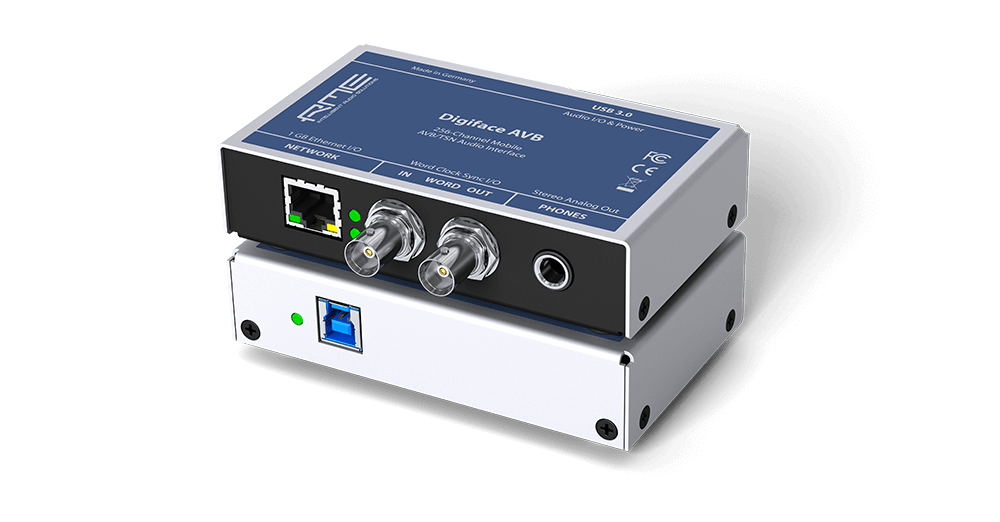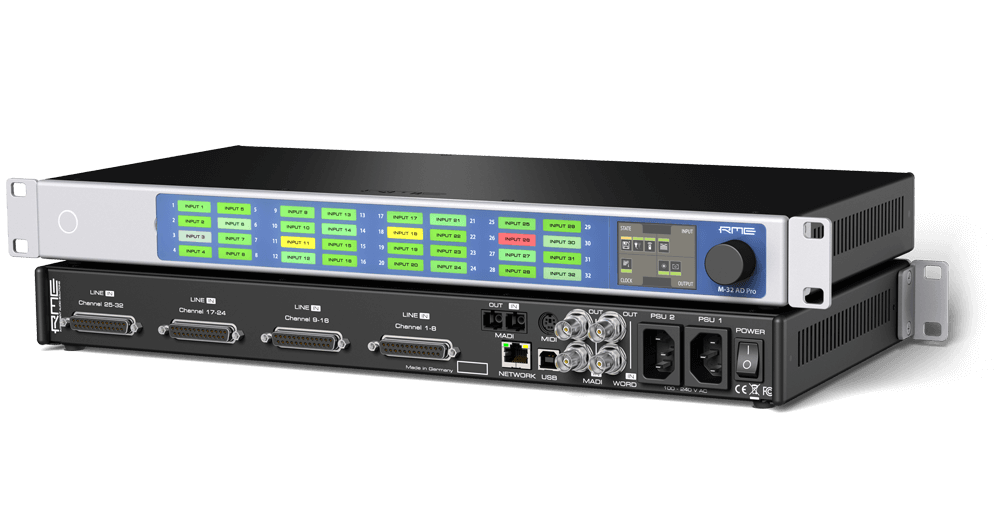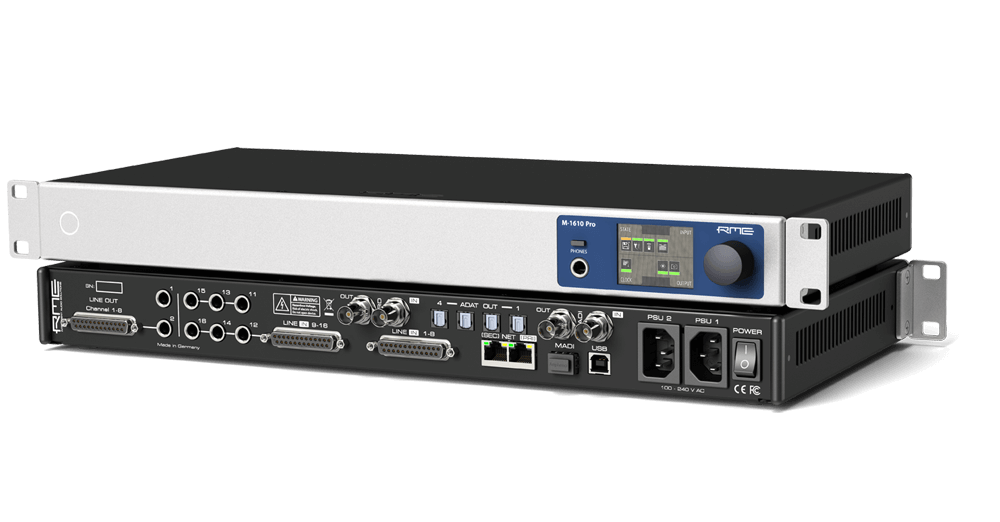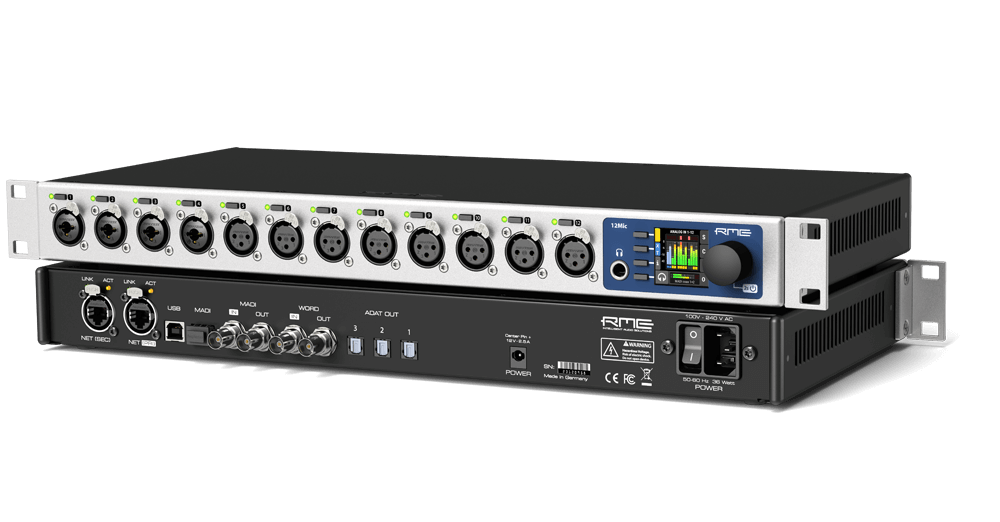AVB Tool
9,5‘‘ MADI-AVB Wandler mit hervorragender analoger Konnektivität
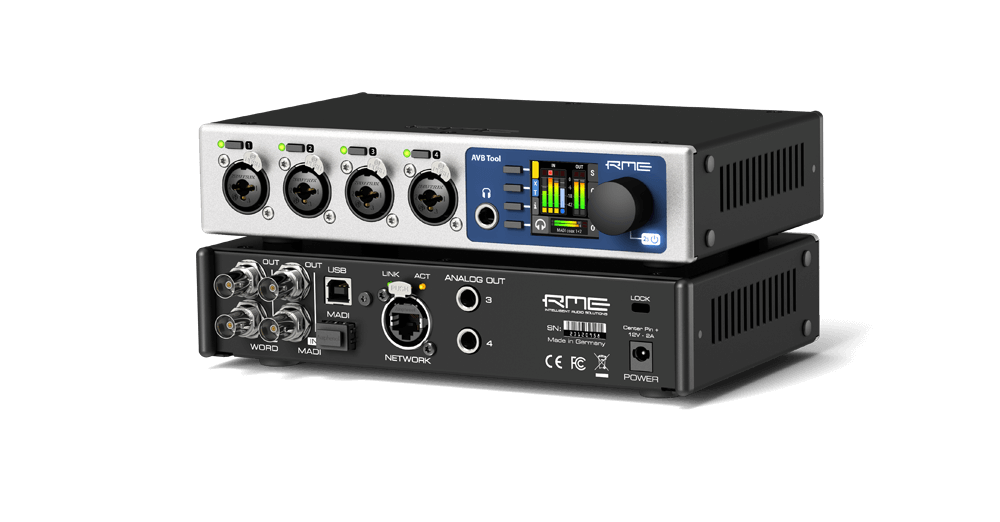
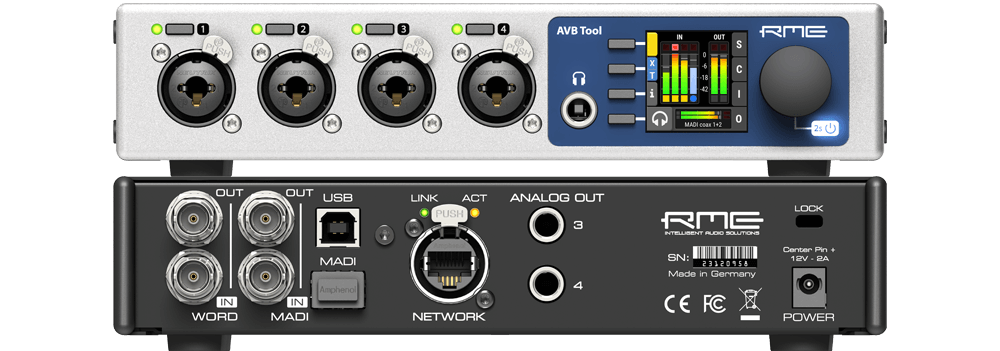
Anschlüsse und Features
Router, Mikrofonvorverstärker, MADI-AVB-Wandler und mehr
Das RME AVB Tool kombiniert MADI und deterministische AVB Netzwerk-Audiosignale mit vier hochauflösenden Mikrofon-, Instrumenten- und Line-Eingängen sowie einem Kopfhörerausgang und separaten Line-Ausgängen. Entsprechend des RME-Konzepts für maximale Vielseitigkeit und Anschlussvielfalt haben die Entwickler das AVB Tool im kompakten Half rack Format zudem um 128 MADI-Ein- und Ausgangskanäle erweitert.
Hochwertige analoge Eingänge
Das AVB Tool ist ein transparenter Analogwandler für die am häufigsten vorkommenden analogen Signale in Leitständen, Recording Studios oder auf der Bühne: vier XLR-TRS Combo-Eingänge mit fernsteuerbarer Verstärkung bis zu 75 dB in 1 dB-Schritten, +18 dBu Line-Eingangsempfindlichkeit, aktivierbarem Hi-Z auf jedem Kanal, einem Stereo-Kopfhörerausgang sowie zwei analogen Line-Ausgängen mit umschaltbarem Referenzpegel (+4/+19 dBu).
Die Stromversorgung erfolgt über ein externes Netzteil (mit verriegelbarem Stecker). Ein Kensington-Schloss sorgt für zusätzlichen Schutz vor Diebstahl.
Das AVB Tool ermöglicht eine lückenlose Redundanz aller MADI-Signale, wenn der sekundäre MADI-Port mit dem gleichen Signal wie der koaxiale MADI-Eingang gespiegelt wird. Für den Fall, dass keine Redundanz erforderlich ist, fungiert das (optionale) optische Single- oder Multimode-MADI-Modul als individueller MADI I/O mit voller Bandbreite.
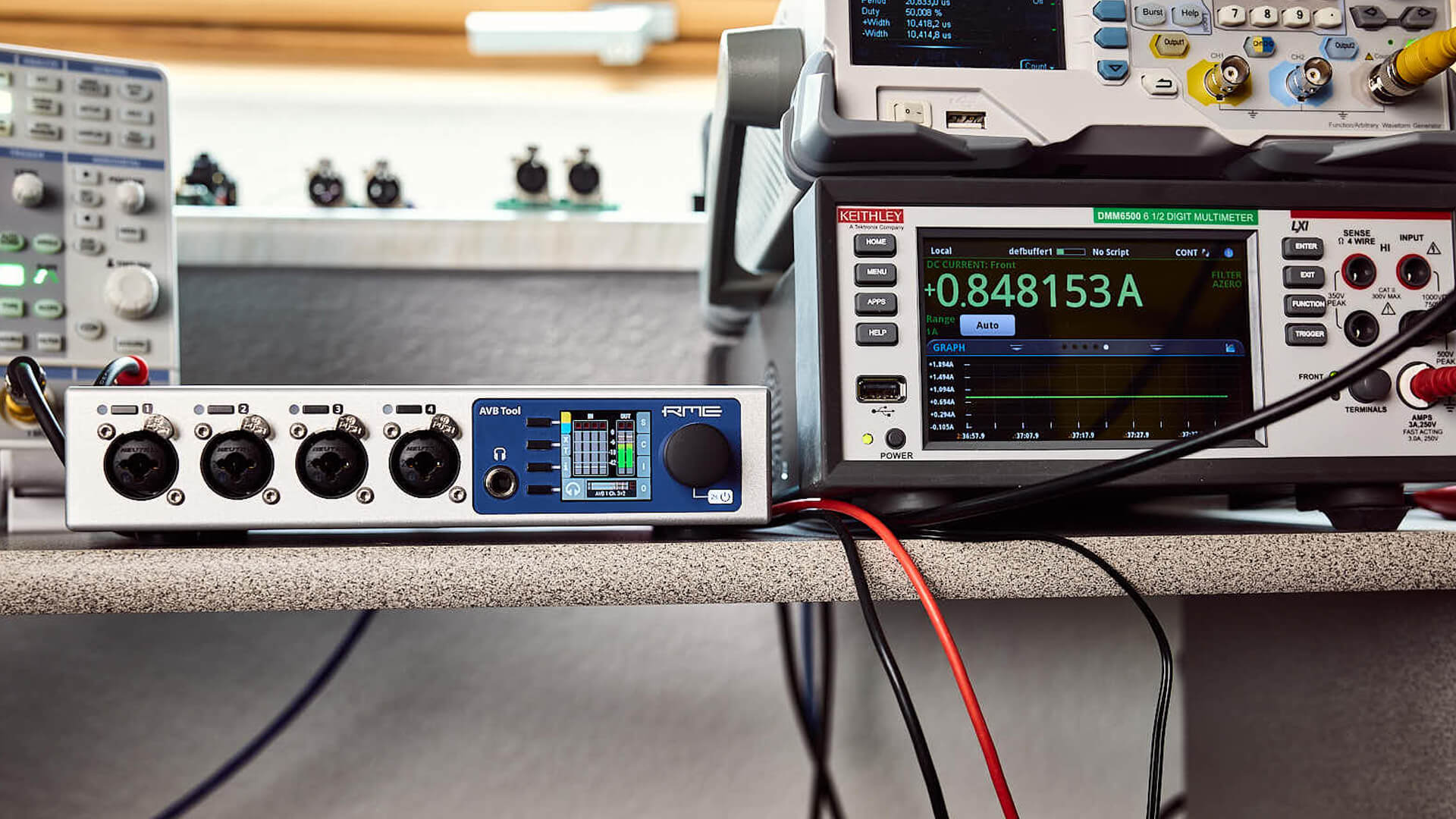
AVB Tool - Bereit für den Einsatz in einer Vielzahl von Anwendungen
Gigabit-AVB mit 8 Streams
AVB-seitig wurde die Anzahl an verfügbaren Streams im RME AVB Core verdoppelt. Damit ermöglicht das AVB Tool nun acht Streams im AM824-Format (Legacy AVB) oder im High Performance AAF-Format (MILAN-kompatibel), inklusive konfigurierbarer Größe und Format pro Stream. Über sämtliche Streams hinweg lassen sich somit bis zu 128 Audiokanäle senden und empfangen.
Das AVB Tool verwendet die gleichen Eingangsstufen wie die ersten vier Kanäle des 12Mic und kombiniert Komponenten des Fireface UFX II und UFX+ in einem neuen AD-Wandler, ergänzt um aktivierbare Hi-Z-Eingänge, symmetrische Stereo-Line-Eingänge sowie zwei symmetrische Line-Ausgänge für das Monitoring auf der Frontseite.
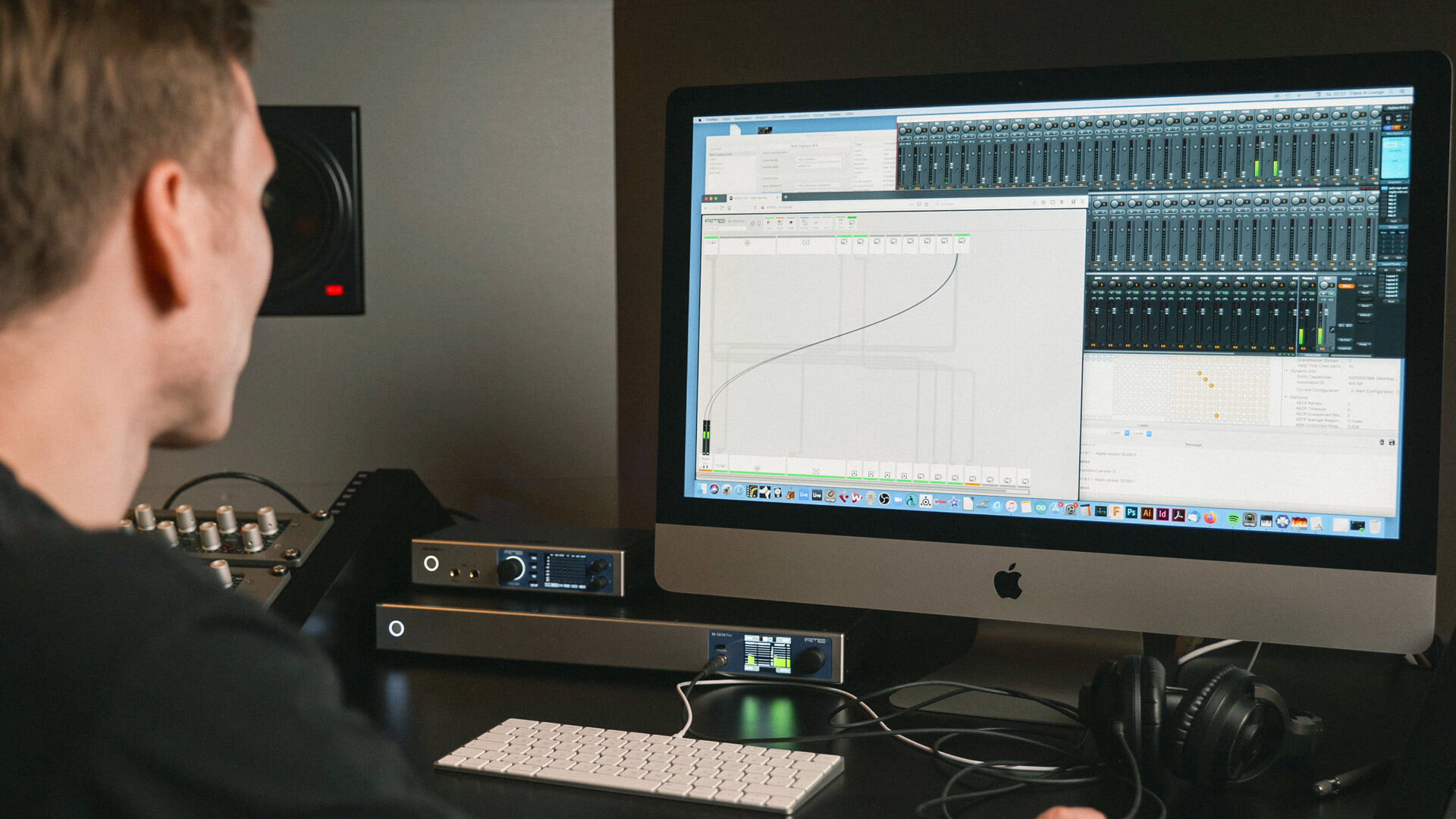
Direkter Zugriff auf alle Funktionen über das Web-Interface in jedem Netzwerk
Plug & Play – schnelle Nutzerinteraktion
Alle Gerätezustände lassen sich mittels Drehgeber und mehreren Tastern unmittelbar über die Frontplatte steuern und bieten einen komfortablen und direkten Zugriff auf sämtliche Funktionen. Darüber hinaus können die RME AVB-Geräte über ein Web-Interface oder eine beliebige Netzwerk-Verbindung (inkl. W-LAN) umfassend ferngesteuert werden und ermöglichen das schnelle Erstellen von Gain-Gruppen, das Aktivieren/Deaktivieren der Phantomspeisung sowie das Routen von Signalen auf den Kopfhörerausgang zu Monitoringzwecken.
Die integrierte Routing-Matrix ermöglicht das schnelle Routen jedes analogen Eingangs – sowie aller digitalen Signale und AVB-Streams – direkt auf den Kopfhörerausgang. Auf diese Weise gestaltet sich die Lösung von Signal-, Clocking-, Verbindungs- oder anderen Problemen einfach und effizient.
SteadyClock FS
Für digitales Audio ist die Taktung, oft „Clocking“ genannt, von entscheidender Wichtigkeit. Sie bildet die Referenz für die Abfolge der Audio-Bits. Leider ist dieser Referenztakt oft nicht so stabil, wie er theoretisch sein sollte. Das AVB Tool bietet deshalb die volle SteadyClock FS Unterstützung für niedrigsten Jitter und höchste Jitterimmunität.
Das garantiert hervorragende Leistung in allen Clock Modi und eine qualitative hochwertige analoge Konvertierung, damit Sie Ihren Mix so hören, wie er auch tatsächlich klingt. Die digitale Formatkonvertierung in RME Produkten erfolgt ohne Verlust oder Beeinträchtigung, und SteadyClock FS stellt sicher, dass immer ein präzises Klangbild ohne Beeinträchtigung ausgegeben wird. Dies hilft bei der Optimierung von Aufnahmen und Mischungen, denn dadurch bekommt das Klangspektrum insgesamt mehr Tiefe und Klarheit.
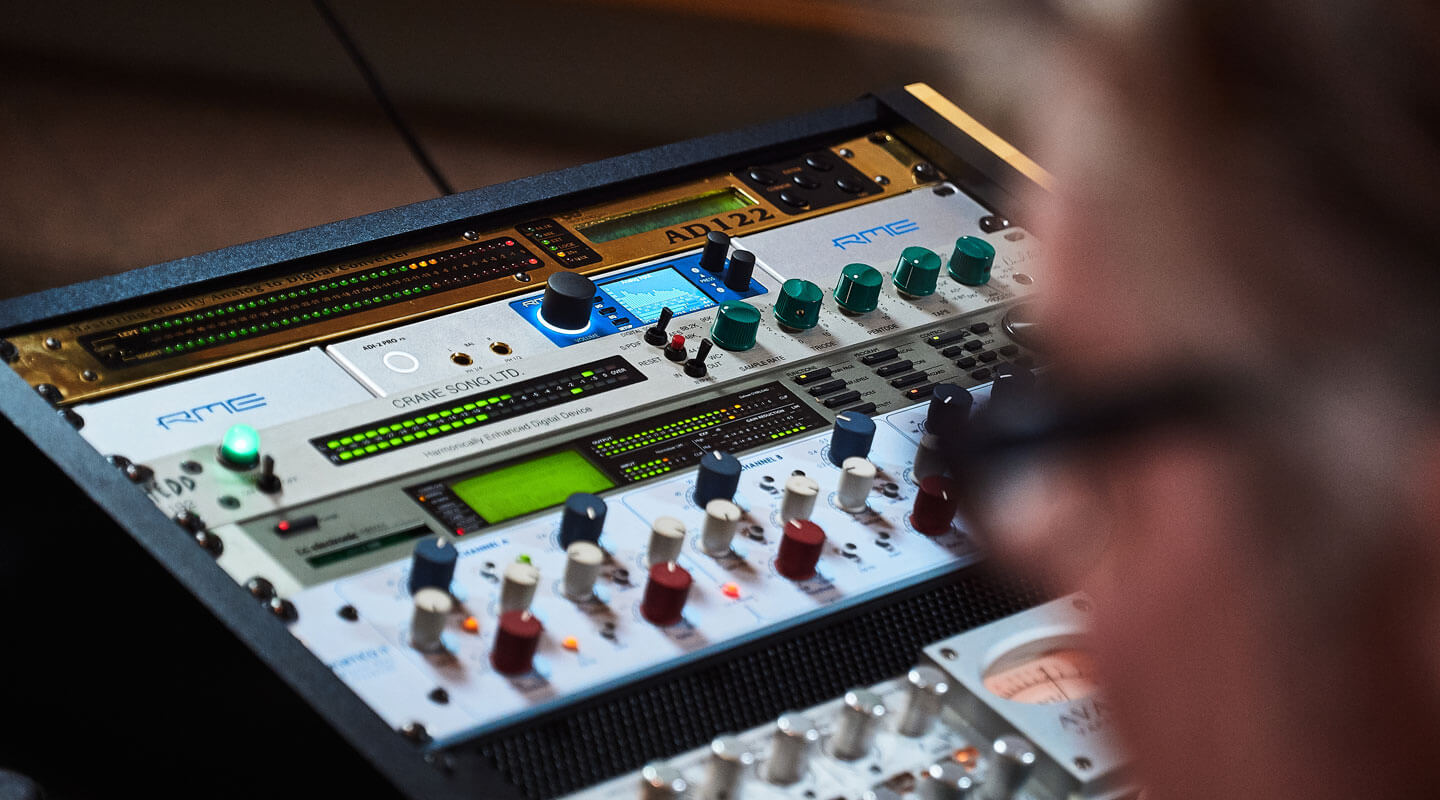
SteadyClock FS Technologie aus der zahllosen preisgekrönten ADI-2-Serie.
About MADI - Multi Channel Digital Audio Protocol
MADI is a protocol that has evolved alongside RME to be the most widely accepted multi channel digital audio protocol on the market. RME’s MADI-based systems deliver incredible reliability, particularly in applications where failure is not an option.
Zubehör
Optisches MADI SFP-Modul (optional erhältlich)
Dieses Modul erweitert kompatible RME-Geräte mit einem optischen SFP-Transceiver. Bis zu 64 Audiokanäle können dann zu anderen MADI-Geräten gesendet und von anderen MADI-Geräten empfangen werden. DAS RME SFP-Modul ist in einer Multi-Mode- und in einer Single-Mode-Version erhältlich, es kann bei eingeschaltetem RME MADI -Gerät eingesetzt und entfernt werden. Es ist nicht notwendig, das Gerät auszuschalten.
Tech-Specs
Inputs
XLR In 1-4:
- Input: XLR, electronically balanced
- Input impedance: 3.4 kOhm
- Gain range: 75 dB, 1 dB steps
- Resolution AD: 24 bit
- Frequency response @ 44.1 kHz, -0.1 dB: 8 Hz – 20.8 kHz
- Frequency response @ 96 kHz, -0.5 dB: 4 Hz – 29.2
- Frequency response @ 192 kHz, -1 dB: 3 Hz – 43.7
- THD @ 30 dB gain: < -110 dB, < 0.00032 %
- THD+N @ 30 dB gain: < -104 dB, < 0.00063 %
- Channel separation: > 110 dB
- Signal to Noise ratio (SNR): > 117 dB RMS unweighted, > 120 dB(A)
- Equivalent Input Noise (EIN), 30 dB Gain: 123 dB RMS unweighted, 125.5 dB(A) @ 150 Ohm
- Maximum input level, Gain 0 dB: +18 dBu
- Maximum input level, Gain 75 dB: -57 dBu
TRS In 1-4:
As above, but:
- Signal to Noise ratio (SNR): 115 dB RMS unweighted, 118 dBA
- TRS jack, balanced
- Gain range: 42 dB, 1 dB steps
- Maximum input level, Gain 8 dB: +20 dBu
- Maximum input level, Gain 50 dB: -22 dBu
- Switchable high impedance (unbalanced TS): 1 MOhm
MADI:
- Coaxial via BNC, 75 Ohm, according to AES10-1991
- Optical via optional SFP module
- 62.5/125 and 50/125 compatible
- Accepts 56 channel and 64 channel mode, plus 96k Frame
- Single Speed: up to 64 channels 24 bit 48 kHz
- Double Speed: up to 32 channels 24 bit 96 kHz
- Quad Speed: up to 16 channels 24 bit 192 kHz
Word Clock:
- 75 ohm Word Clock BNC connectivity
- Support 44.1kHz - 192kHz
- Support full or single speed operation
- SteadyClock FS extracts low jitter clock signal
- Intelligent Clock Control switches clock source seamlessly
Outputs
Analog Out 3/4:
- Output: two 6.3 mm TRS mono (balanced) jacks
- Maximum output level at 0 dBFS: +4 dBu or +19 dBu
Phones 1/2:
- Resolution: 24 Bit
- Noise (DR): 115 dB RMS unweighted, 118 dBA
- Frequency response @ 44.1 kHz, -0.5 dB: 9 Hz – 22 kHz
- Frequency response @ 96 kHz, -0.5 dB: 9 Hz – 45 kHz
- Frequency response @ 192 kHz, -1 dB: 8 Hz - 75 kHz
- THD+N: < -100 dB, < 0.001 %
- Channel separation: > 110 dB
- Output: 6.3 mm TRS stereo (unbalanced) or mono (balanced) jack
- Maximum output level at 0 dBFS: +13 dBu (unbalanced), +19 dBu (balanced)
MADI:
- Coaxial via BNC, 75 Ohm, according to AES10-1991
- Optical via optional SFP module
- 62.5/125 and 50/125 compatible
- Accepts 56 channel and 64 channel mode, plus 96k Frame
- Single Speed: up to 64 channels 24 bit 48 kHz
- Double Speed: up to 32 channels 24 bit 96 kHz
- Quad Speed: up to 16 channels 24 bit 192 kHz
Word Clock:
- 75 ohm Word Clock BNC connectivity
- Support 44.1kHz - 192kHz
- Support full or single speed operation
- SteadyClock FS extracts low jitter clock signal
- Intelligent Clock Control switches clock source seamlessly
General
- 1 x RJ45 1 GigE AVB, 8 streams (each up to 16 ch.) per direction
- MADI input redundancy (requires optional SFP module)
- Internal routing of up to 260x260 channels
- MADI-AVB conversion
- 1,54” full color display with control knob and four buttons for convenient, direct access to all features
- SteadyClock FS - ultra-low jitter digital clock technology
- Remote control via HTTP, JSON, IEEE 1722.1, ATDECC, MIDI over MADI
- USB 2.0 (for remote control and firmware updates)
- DC-coupled outputs
- K-slot lock port
Hardware Specifications
- Dimensions: 215 x 44 x 130 mm (8.5 x 1.7 x 5.1 inches)
- Weight: 1.0 kg (2.2 lbs)
- Package: 347 x 216 x 83 mm (13.7 x 8.5 x 3.3 inches)
- Conformity: CE, FCC, WEEE, RoHS
- Power supply: external 2 A 100-240 V AC
- Power consumption: typ. 13W, standby 0.5W
- Power consumption: typ. 20 W, standby 0.5W
All specifications are subject to change without notice.
Treiber
Version 2.0.0 with support for the 12Mic, 12Mic-D, AVB Tool and OctaMic XTC, requires macOS 10.15 or newer!
Version 2.0.0 with support for the 12Mic, 12Mic-D, AVB Tool and OctaMic XTC, requires macOS 10.15 or newer!
Version 1.0.0 with support for the 12Mic, AVB Tool, and OctaMic XTC.
Version 2.0.0 with support for the 12Mic, 12Mic-D, AVB Tool and OctaMic XTC, requires Windows 10 or newer!
Version 1.0.0 with support for the 12Mic, AVB Tool, and OctaMic XTC.
Firmware 1.7.1. Main update. Carefully read the instructions in the readme.pdf!

